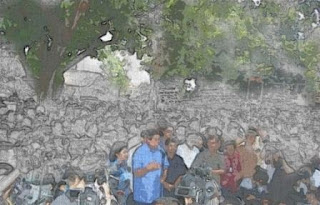On December 29, 2010, Gelora Bung Karno, the main Sports Stadium located in Senayan, Jakarta, was full of enthusiastic spectators watching the grand final of Asean Football Federation (AFF) Suzuki Cup. The match was very decisive for Indonesia as their favorite team was soundly defeated by Malaysia in the first leg which was held in Kuala Lumpur three days earlier.
At that night the sports stadium bearing the nickname of Soekarno, the then president who initiated to build the area, looked grandiose and impressive. It was flooded by the football spectators and all of its 90,000 seats were full dominated by red costumes yelling to support the Indonesia soccer team. The sports stadium was built in the middle of Senayan sports center measured by 137 hectares. In the new order era (1966 – 1998), when de-Soekarnoism was very intense the name was temporarily changed into Stadion Utama Senayan.
The construction of the sports center and other burdening prestigious projects which were started in the early 1960s put a lot of additional burden to the Indonesian economy which was already worsened.
Soekarno as the first president and also the founding father of Indonesia believed that as a young nation, Indonesia should give priority to the nation and character building as the precondition to becoming a great nation.
Albeit the weakness of Indonesia economy, he decided to build a Grand National Sports Center and declared that Indonesia was ready to host the Asian Games by 1962. Many member countries such as Japan and China were skeptical as Indonesia at those days didn’t have any good infrastructure yet.
Now, fifty years later, on the night of December 29th, the sense of nationalism of the Indonesians spectators tremendously surged. Indonesia has never had a strong national soccer team. Since the AFF Cup establishment in the 1990s, Indonesia has been able to reach the final for 3 times, but so far never won any of them. Strengthened by two naturalized foreign players who have a close attachment to Indonesia, and under the coach Alfred Riedl who imposes a very rigorous discipline, for the first time, Indonesia has a better football team which they are proud of.
At that night the sports stadium bearing the nickname of Soekarno, the then president who initiated to build the area, looked grandiose and impressive. It was flooded by the football spectators and all of its 90,000 seats were full dominated by red costumes yelling to support the Indonesia soccer team. The sports stadium was built in the middle of Senayan sports center measured by 137 hectares. In the new order era (1966 – 1998), when de-Soekarnoism was very intense the name was temporarily changed into Stadion Utama Senayan.
The construction of the sports center and other burdening prestigious projects which were started in the early 1960s put a lot of additional burden to the Indonesian economy which was already worsened.
Soekarno as the first president and also the founding father of Indonesia believed that as a young nation, Indonesia should give priority to the nation and character building as the precondition to becoming a great nation.
Albeit the weakness of Indonesia economy, he decided to build a Grand National Sports Center and declared that Indonesia was ready to host the Asian Games by 1962. Many member countries such as Japan and China were skeptical as Indonesia at those days didn’t have any good infrastructure yet.
Many criticisms accusing the project as a megalomaniac one wasting money which was needed badly for more urgent development of public welfare. Even Khrushchev, the then Soviet Union Prime Minister, was more pragmatic and kindly reminded Soekarno to prioritize the welfare of his people. However, Soekarno had a strong determination to continue the construction. The project was funded by a soft loan from the Soviet Union amounting to US$12.5 million. Although facing many obstacles, the project was finally completed on schedule.
 Indonesia team had successfully stepped into the final, but in the first leg of the final match held in Kuala Lumpur three days earlier Indonesia was beaten by Malaysian team by three goals.
Indonesia team had successfully stepped into the final, but in the first leg of the final match held in Kuala Lumpur three days earlier Indonesia was beaten by Malaysian team by three goals. The Indonesia team performance seemed very poor at that match but the matter became worse as during the match, the Indonesian goal keeper was bombarded by green lasers disabling him to concentrate.
Following the incident, Indonesia sent an official complaint to Asian Football Confederation (AFC). It is hoped that the AFC would not simply ignore the Bukit Jalil sport stadium's laser incident which directly disturbed the guest players.
Now in the second leg, Indonesian team won the match at score of 2 - 1 and should be happy to become as the runner up of the 2010 AFF Cup. It was unimportant whoever the champion was as far as it was a fair play. More importantly the Indonesian supporters and may be the whole nation were united and forgot for a while their internal political quarrels. The sport has been proved to be the vehicle for strengthening the nation and character building.



























